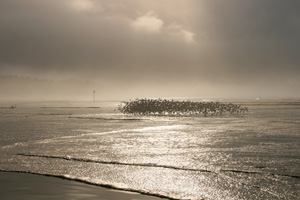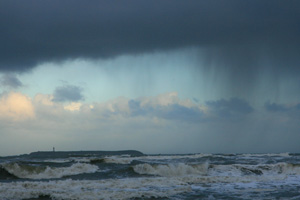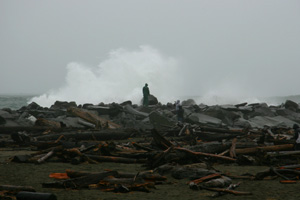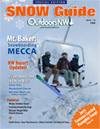Best Storm-Watching Spots on the Washington Coast

Thar She Blows!
Story and Photos by Greg Johnston
Photo at right: A heavy, storm-driven surf crashes below North Head Lighthouse at Cape Disappointment State Park, Wash.
The Washington Coast is magical in any weather.
When seas are calm the living’s easy, razor clam digging and surf perch fishing are optimal and it’s the perfect time for a stroll along this spectacular edge where sea and sky meet and tectonic plates collide.
But, when the storm winds blow in off the mighty Pacific, the raw spectacle of it all can be astonishing. Waves crash and catapult. The wind doesn’t howl, it screams. And, the rain doesn’t fall, it pummels.
If you’re flexible and study the forecast — as any lover of the coast must — post-blow coastal hiking can offer the best agate-hunting and beach-combing.
History indicates vividly that this coast does take a regular beating, which is an appropriate way to launch into the following list of great spots on the Washington Coast to watch a storm.
Cape Disappointment State Park
No question, “Cape D” State Park is one of the best in the state, with prime spots for watching Poseidon’s fury. North Head is one of the windiest spots on the Washington Coast. In the park’s former incarnation as Fort Canby, a weather station here once recorded a gust of 126 mph — just before the gauge blew away.
North Head Lighthouse (circa 1898) is an exquisite structure on a rocky perch 129 feet above the ocean and Benson Beach. For a measured dose of stormy weather, take a trail less than an eighth of a mile from the North Head parking area to the light, where a bench provides a superb roost to watch the show.
The park’s other lighthouse, Cape Disappointment Light, is another great perch, some 167 feet above the mouth of the mighty Columbia River and first lit in 1856 to guide Mariners through the “Graveyard of the Pacific,” as it’s called.
The hike is a quarter-mile from the Lewis and Clark Interpretive Center parking lot. If it’s not blowing gale-strength, it’s worth donning the rain gear and hiking out to watch whitecaps frothing here-to-horizon.
Remember, you need a state Discover Pass ($10 daily or $30 annually) to park here. The park has a fine campground. And, you can rent the stately North Head light-keepers’ quarters; they’re pricy but roomy.
One of the neat things about Cape D Park is that it sits at the base of the 28-mile Long Beach Peninsula, which offers a range of accommodations, many with ocean views. It also offers great restaurants, like The Depot, the Shelburne Restaurant and Pub, and 42nd Street Café in Seaview, and Jimella and Nanci’s Market Cafe in Ocean Park. My vote for the peninsula’s best storm-watching bar? The Pickled Fish atop the Adrift Hotel in Long Beach.
Pacific Beach
The stretch of the coast from Ocean Shores north to Moclips is the epicenter of razor clam habitat in Washington and my favorite part of it is in and around the town of Pacific Beach. Here, I can truthfully say, I have excavated a limit of razor clams during a raging gale. It isn’t easy, in fact it’s downright crazy — but possible, with persistence.
It was on a winter nighttime minus tide, the rain was coming down almost sideways, the surf was snarly, and the six of us worked in pairs, one holding the lantern and watching the surf while the other spotted the telltale “shows” in the sand.
I managed a limit of 15, while the other two diggers got a couple each. We repaired to the Ocean Crest Resort, cold, sodden and sandy, and went back into our warm room. The others commented on what a crazy idea it had been (mine). But a blissful grin raged across my face.
The next day we drove just south to a favorite coastal dive, the Green Lantern Tavern in Copalis Beach, and enjoyed beers, burgers and billiards while watching logs and limbs sweep down the swollen Copalis River.
What makes the Pacific Beach area a peach of a place to watch the Pineapple Express is its trio of traditional, old-time resorts right on the ocean: Iron Springs Resort, recently renovated stem to stern; the Sandpiper Resort, basically mere feet from the high-tide line; and the aforementioned Ocean Crest.
For a great hike nearby, check out Copalis Spit, all of it protected as Griffith-Priday Ocean State Park (day-use only). Here the tidal reaches of the Copalis River meander past a mile-long sandpit before spilling into the Pacific. Beach driving is not allowed here since it is managed as a wildlife preserve.
Legend has it that occasionally silver dollars dating to the 1880s are found on the beach here, allegedly washed in by storms from a ship that foundered back then.
Kalaloch
Arguably the best beachcombing in the state is in the Kalaloch area near Forks, located more than 11 miles off Hwy 101 parallel to the Pacific Ocean. In the dialect of the Salish-speaking Quinault tribe, Kalaloch meant “good place to land,” as in a canoe. These largely sandy shores also gently receive cool flotsam, such as the prized Japanese glass fishing-float.
The rustic and time-weathered Kalaloch Lodge is my all-time favorite resort on the entire coast. And, the National Park Service’s adjacent Kalaloch Campground is my favorite campground on the coast.
If you have a trailer or an RV, there might not be a better place to pull up and watch an ocean storm than the bluff-top sites at Kalaloch Campground. Likewise, the bluff-top cabins and rooms at Kalaloch Lodge are superb for watching waves and weather.
Here I learned the lesson about timing. We arrived at our cabin during a wicked storm so we cozied up in the cabin and played games (no TV here). By dawn the storm had broken. I pulled on hiking boots and hit the beach, where I found a green glass fishing float as big as a basketball.
The beach hiking here is phenomenal, more than 10 miles of it, with only three headlands that pose impediments, and these can be rounded on tides of less than 2 or 3 feet.
This entire stretch is part of Olympic National Park’s exquisite and unparalleled 70-mile wilderness beach strip. It has not changed much at all since Lieutenant Juan Francisco de la Bodega y Quadra sailed by here in 1775 in the schooner Sonora.
Other options
If you’re looking for more places to watch dramatic torrents of rain meeting the ocean, head to La Push or the Neah Bay area and prepare to have your socks knocked off. Check our Resources section for ideas on where to stay.
Resources
Cape Disappointment State Park: www.parks.wa.gov/486/Cape-Disappointment
North Head Lighthouse: www.parks.wa.gov/241/North-Head-Lighthouse
Long Beach Peninsula Visitor’s Bureau: www.funbeach.com
The Depot Restaurant, Seaview: www.depotrestaurantdining.com
Shelburne Restaurant and Pub, Seaview: www.theshelburnerestaurant.com
42nd Street Café, Seaview: www.42ndstcafe.com
Jimella and Nanci’s Market Cafe, Ocean Park: www.jimellaandnancis.com
Adrift Hotel, Long Beach: www.adrifthotel.com
Green Lantern Tavern, Copalis Beach: www.facebook.com/GreenLanternPub
Iron Springs Resort, Copalis Beach: www.ironspringsresort.com
Sandpiper Resort, Pacific Beach: www.sandpiper-resort.com
Ocean Crest Resort, Moclips: www.oceancrestresort.com
Griffith-Priday Ocean State Park: parks.wa.gov/516/Griffith-Priday-Ocean
Kalaloch Lodge, Forks: www.thekalalochlodge.com
Kalaloch Campground: www.nps.gov/olym/planyourvisit/campgrounds.htm
Olympic National Park Coast: www.nps.gov/olym/planyourvisit/wilderness-coast.htm
The Quileute Tribe’s Oceanside Resort, La Push: www.quileuteoceanside.com
Hobuck Beach Resort, Neah Bay: www.hobuckbeachresort.com
Storm-Watching Smarts
Witnessing a storm pummel the ocean shore is an exhilarating way to experience the often stunning power of nature, but without a dose of caution, you could be the one getting stunned.
- Do not stand atop a jetty during a blow, not even to feel the sea’s briny spray. We watched several foolish people do this on the Grays Harbor north jetty during a storm driving 20-foot swells. A big one eventually knocked two men into the rocks below. One guy fractured his leg.
- If you’re hiking the beach, keep well above the surf line, don’t play chicken with the waves. Rogue waves have swept many people out to sea, and in a storm, lots of big curlers crash in. Never turn your back on
the surf. - Be aware of high tide and drift logs. When the tide is high it can trap you against bluffs and carry you away. A big surf can toss around massive logs like an angry grizzly snapping sticks. Every so often a person is killed or injured on the Washington Coast this way.
- If lightning is flashing, watch the storm from your cabin or favorite beachside bar, so you can get a safe buzz without being lit up!
~G.J.
Greg Johnston is a Western Washington native and former outdoors reporter for the Seattle Post-Intelligencer newspaper. His guidebook to the Washington Coast will be published in the spring of 2015 by Mountaineers Books.






